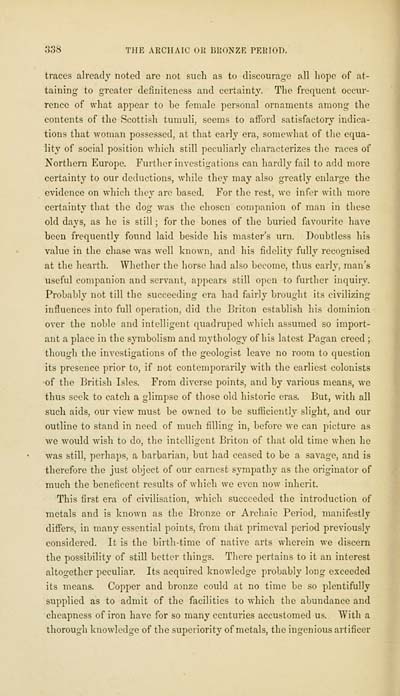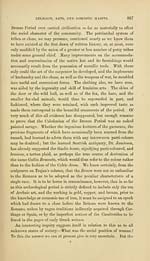Download files
Complete book:
Individual page:
Thumbnail gallery: Grid view | List view

3o8 THE ARCHAIC OH BliONZR PEIMOD.
traces already noted arc not such as to discourage all hope of at-
taining to greater definiteness and certainty. The frequent occur-
rence of what appear to be female personal ornaments among the
contents of the Scottish tumuli, seems to afford satisfactory indica-
tions that woman possessed, at that early era, somewhat of tlie equa-
lity of social position which still peculiarly characterizes the races of
Northern Europe. Further investigations can hardly fail to add more
certainty to our deductions, while they may also greatly enlarge the
evidence on which they are hased. For the rest, we infer with more
certainty that the dog was the chosen companion of man in these
old days, as he is still ; for the bones of the buried favourite have
been frequently found laid beside his master's urn. Doubtless his
value in the chase was well known, and his fidelity fully recognised
at the hearth. Whether the horse had also become, thus early, man's
useful companion and servant, appears still open to further inquiry.
Probabl}' not till the succeeding era had fairly brought its civilizing
influences into full operation, did the Briton establish his dominion
over the noble and intelligent quadruped which assumed so imjjort-
ant a place in the symbolism and mythology of his latest Pagan creed ;
though the investigations of the geologist leave no room to question
its presence prior to, if not contemporarily with the earliest colonists
•of the British Isles. From diverse points, and by various means, we
thus seek to catch a glimpse of those old historic eras. But, with all
such aids, our view must be owned to be sufficiently slight, and our
outline to stand in need of much filling in, before we can picture as
we would wish to do, the intelligent Briton of that old time when he
was still, perhaps, a barbarian, but had ceased to be a savage, and is
therefore the just object of our earnest sympathy as the originator of
much the beneficent i-esults of which we even now inherit.
This first era of civilisation, which succeeded the introduction of
metals and is known as the Bronze or Archaic Period, manifestly
differs, in many essential points, from that primeval period previously
considered. It is the birth-time of native arts wherein we discern
the possibility of still better things. There pertains to it an interest
altogether peculiar. Its acquired knowledge probably long exceeded
its means. Copper and bronze could at no time be so j^lentifuUy
supplied as to admit of the facilities to which the abundance and
cheapness of iron have for so many centuries accustomed us. With a
thorough knowledge of the superiority of metals, the ingenious artificer
traces already noted arc not such as to discourage all hope of at-
taining to greater definiteness and certainty. The frequent occur-
rence of what appear to be female personal ornaments among the
contents of the Scottish tumuli, seems to afford satisfactory indica-
tions that woman possessed, at that early era, somewhat of tlie equa-
lity of social position which still peculiarly characterizes the races of
Northern Europe. Further investigations can hardly fail to add more
certainty to our deductions, while they may also greatly enlarge the
evidence on which they are hased. For the rest, we infer with more
certainty that the dog was the chosen companion of man in these
old days, as he is still ; for the bones of the buried favourite have
been frequently found laid beside his master's urn. Doubtless his
value in the chase was well known, and his fidelity fully recognised
at the hearth. Whether the horse had also become, thus early, man's
useful companion and servant, appears still open to further inquiry.
Probabl}' not till the succeeding era had fairly brought its civilizing
influences into full operation, did the Briton establish his dominion
over the noble and intelligent quadruped which assumed so imjjort-
ant a place in the symbolism and mythology of his latest Pagan creed ;
though the investigations of the geologist leave no room to question
its presence prior to, if not contemporarily with the earliest colonists
•of the British Isles. From diverse points, and by various means, we
thus seek to catch a glimpse of those old historic eras. But, with all
such aids, our view must be owned to be sufficiently slight, and our
outline to stand in need of much filling in, before we can picture as
we would wish to do, the intelligent Briton of that old time when he
was still, perhaps, a barbarian, but had ceased to be a savage, and is
therefore the just object of our earnest sympathy as the originator of
much the beneficent i-esults of which we even now inherit.
This first era of civilisation, which succeeded the introduction of
metals and is known as the Bronze or Archaic Period, manifestly
differs, in many essential points, from that primeval period previously
considered. It is the birth-time of native arts wherein we discern
the possibility of still better things. There pertains to it an interest
altogether peculiar. Its acquired knowledge probably long exceeded
its means. Copper and bronze could at no time be so j^lentifuUy
supplied as to admit of the facilities to which the abundance and
cheapness of iron have for so many centuries accustomed us. With a
thorough knowledge of the superiority of metals, the ingenious artificer
Set display mode to: Large image | Transcription
Images and transcriptions on this page, including medium image downloads, may be used under the Creative Commons Attribution 4.0 International Licence unless otherwise stated. ![]()
| Early Gaelic Book Collections > J. F. Campbell Collection > Archaeology and prehistoric annals of Scotland > (380) |
|---|
| Permanent URL | https://digital.nls.uk/78375854 |
|---|
| Description | Volumes from a collection of 610 books rich in Highland folklore, Ossianic literature and other Celtic subjects. Many of the books annotated by John Francis Campbell of Islay, who assembled the collection. |
|---|
| Description | Selected items from five 'Special and Named Printed Collections'. Includes books in Gaelic and other Celtic languages, works about the Gaels, their languages, literature, culture and history. |
|---|

